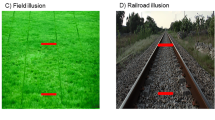Abstract
Bayesian parameter estimation can be used to generate statistically optimal solutions to the problem of cue integration. However, the complexity and dimensionality of these solutions is frequently prohibitive. In this paper, we show how the complexity and performance characteristics of the optimal estimator for a task depend strongly on the detailed formulation of the task, including the choice of representation for the scene variables. In particular, some representations lead to simpler inference algorithms than others. We illustrate the problem of cue integration for the perception of depth from two highly disparate cues, cast shadow position and image size, and show how the complexity and performance of the depth estimators depends on the specific representation (choice) of depth parameter. From the analysis we predict human performance on a simple depth discrimination task from the optimal cue integration in each depth representation. We find that the cue-integration strategy used by human subjects can be described as near-optimal using a particular choice of depth representation.
Similar content being viewed by others
References
Blake, A., Bulthoff, H.H., and Sheinberg, D. 1996. Shape from texture: Ideal observers and human psychophysics. In Perception as Bayesian Inference, D.C. Knill and W. Richards (Eds.). Cambridge University Press: New York, pp. 287–321.
Brainard, D.H. and Freeman, W.T. 1997. Bayesian color constancy. J. Opt. Soc. Am. A, 14(7):1393–1411.
Clark, J.J. and Yuille, A.L. 1990. Data Fusion for Sensory Information Processing Systems. Kluwer Academic Publishers: Boston.
Cutting, J.E. and Vishton, P.M. 1996. Perceiving layout and knowing distances: The integration, relative potency, and contextual use of different information about depth. In Perception of Space and Motion, W. Epstein and S. Rogers (Eds.). Academic Press: San Diego, pp. 69–117.
Edwards, A.W.F. 1992. Likelihood. Johns Hopkins University Press: Baltimore.
Freeman, W.T. 1994. The generic viewpoint assumption in a framework for visual perception. Nature, 368:542–545.
Goodale, M.A., Meenan, J.P., Bulthoff, H.H., Nicolle, D.A., Murphy, K.J., and Racicot, C.I. 1994. Separate neural pathways for the visual analysis of object shape in perception and prehension. Current Biology, 4(7):604–610.
Jensen, F.V. 1996. An Introduction to Bayesian Networks. Springer: New York.
Kersten, D., Knill, D., Mamassian, P., and Buelthoff, I. 1996. Illusory motion from shadows. Nature, 379(6560):31.
Kersten, D., Mamassian, P., and Knill, D.C. 1997. Moving cast shadows induce apparent motion in depth. Perception, 26:171–192.
Knill, D.C. and Kersten, D. 1991. Apparent surface curvature affects lightness perception. Nature, 351:228–230.
Landy, M.S., Maloney, L.T., Johnson, E.B., and Young, M. 1995. Measurement and modeling of depth cue combination: In defense of weak fusion. Vision Research, 35:389–412.
Lawson, S., Madison, C., and Kersten, D. 1998. Depth from cast shadows and size-change: Predictions from statistical decision theory. Investigative Opthamology and Visual Sciences (ARVO), 39(5):827.
Pearl, J. 1988. Probabilistic Reasoning in Intelligent Systems: Networks of Plausible Inference. Morgan Kaufmann: San Mateo, CA.
Rao, C. 1973. Linear Statistical Inference and Its Applications. John Wiley and Sons: New York.
Stevens, S.S. 1957. On the psychophysical law. The Psychological Review, 64(3):153–181.
Tanner, M.A. 1996. Tools for Statistical Inference. Springer: New York.
Yuille, A.L. and Bulthoff, H.H. 1996. Bayesian decision theory and psychophysics. In Perception as Bayesian Inference, D.C. Knill and W. Richards (Eds.). Cambridge University Press: New York, pp. 123–161.
Author information
Authors and Affiliations
Rights and permissions
About this article
Cite this article
Schrater, P.R., Kersten, D. How Optimal Depth Cue Integration Depends on the Task. International Journal of Computer Vision 40, 71–89 (2000). https://doi.org/10.1023/A:1026557704054
Issue Date:
DOI: https://doi.org/10.1023/A:1026557704054




